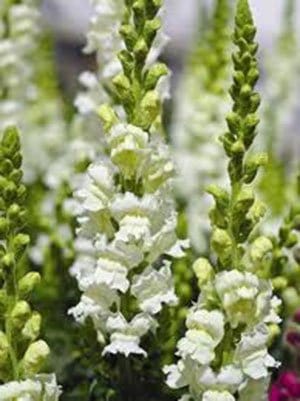
It recently came to my attention that certain snapdragons (and perhaps all, to some extent) are deeply scented. This is news to me. I’ve grown snapdragons, but not noticed any perfume in classic tall Rocket or fully double Madame Butterfly hybrids, or any of the dwarf Little Darling group. Perhaps my receptor is damaged. (I picture myself with bent antennae.)
This revelation came upon me as I was looking for tube-shape annuals to plant for the little hummingbird expected in spring. Snapdragon flowers have five flared petals with volatile scent oils produced on the edges of the petal lobes, and rich nectar stored at the back of the tube. My little hummer would like that.
I’m also fond of bumblebees and anticipate the first ones (queens) to stumble out, all groggy from a winter’s sleep and barely able to elevate their weight. Bumblebees and snapdragons are evolutionary partners—the flowers produce the most nectar during the hours of greatest bumblebee activity. The bees enter the flower and brush against the lobes, catching volatile oil on their fuzzy hairs before squirming toward the nectar farther back. In summer they carry the scent to their hive, stirring up enthusiasm for more visitors to the flowers. The volatile oil in snapdragon petals is a compound of several different chemicals, and the scent gene has been isolated, so who knows where it will turn up. Plant biologists are quite adept at lifting useful genes from one plant and depositing them in another.
The scented flowers I’ve been writing about for the past few weeks produce their perfume in the evening hours and are pollinated by night-flying moths. They’re fine for my odd corners, but I’m pleased to know snapdragons provide scent in daylight, and are pretty enough to put front and centre in the garden beds. Louise Beebe Wilder wrote in The Fragrant Path (1932) that snapdragon “has what the old writers call a ‘stuffing scent,’ rather oversweet and cloying. But as its odour is not given off spontaneously in the open air it need not be annoying to one who does not care for it.” That’s not an encouraging endorsement, but perhaps snapdragon perfume has evolved to something better (and more freely distributed) in the past 80 years.
Snapdragons to grow for scent
Puzzled by my own ignorance of the perfume potential in snapdragons, I searched catalogue descriptions for the snaps I’ve grown (Rocket, Madame Butterfly, Little Darling, Liberty and Ribbon Series) and, sure enough, they’re not described as fragrant, although you might get something sweet if you put your nose right on the petals. But what a pleasant surprise to find the scented Aromas Series, with such colour selections as French Vanilla, Fresh Lemon and Red Spice. Also, the La Bella Series, described as highly scented and good for cut flowers.
I don’t think I’ll be starting seeds of scented snapdragons this year, but you can be sure I’ll be trolling the aisles of garden centres looking for Aromas and La Bella hybrids.

Hi there! Just wondering if you can make essential oil out of its seeds!?
Thanks.
Judith, I was wondering where to buy the seeds for these scented snapdragons?
Judith, I just answered my own question – I checked the website for the local seed store (Stokes) and they have them!